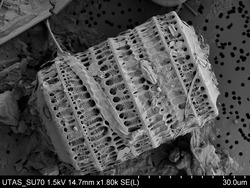Genetically Modified Algae Attack Cancer Cells


Genetically modified diatoms (green) display antibody-binding proteins on their surface (blue). When bound to the cancer cells (purple), the chemotherapy agent is released (yellow). Credit: Marc Cirera & Nature Communications.
An international, multidisciplinar team of scientists lead by researchers from Georgia Institute of Technology and University of South Australia have engineered an algae to deliver chemotherapy drugs to cancer cells. The diatom was genetically modified to display cancer cell-binding proteins in its biosilica surface, while carrying drug particles in its interior. 90% of algae-treated cancer cells died in the in vitro experiments, leaving healthy cells unharmed. The algae also caused tumor growth regression in mice with neuroblastoma. The finding was published in Nature Communications.
Targeted chemotherapy tries to deliver drugs only to cancer cells, avoiding to harm other healthy, dividing cells. A common technique involves the use of silica particles loaded with chemotherapy drugs. However, producing the particles is expensive and requires the use of chemicals. For this reason, lead scientists Nils Kröger and Nicolas H. Voelcker decided to find a biological alternative to the particles. They found it in a microalgae, the diatom Thalassiosira pseudonana, whose cell wall is made of hydrated silicon dioxide or silica.
A biocompatible drug carrier without off-target effects
The researchers genetically modified the unicellular organism to procuce the IgG-binding domain of protein G on the surface. In this way, the silica compartment targets only cancer cells with the specific antibodies. The chemotherapy drugs release selectively killed the neuroblastoma and B-lymphoma cells. In vitro experiments showed that approximately 90% of cancer cells were killed, and tumor growth in mice was also reduced. Mice tissue was not affected by the drugs, and the biosilica was degraded by their bodies.
The researchers expect this new system to have a profound effect in cancer treatment, especially in currently untreatable solid tumors.
Source: UniSA

